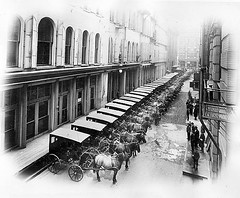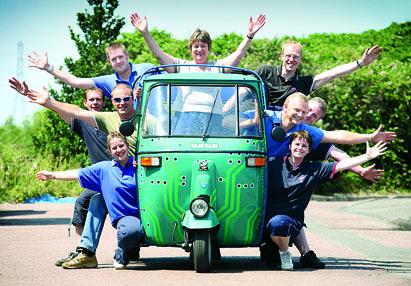Delivery services in the city and the creation of transportation management districts
One of the things I forgot to mention in the blog entry, "Transit without borders or five omissions "in" the Transportation Element of the DC "Comprehensive" Plan" in point five, about mandatory transportation demand management planning across the board, is encouraging delivery services.
If stores and "shopping centers" provided delivery services, like stores did in the old days, then that would make buying big things easier, and further reduce the need for driving around to do things.
 Delivery vehicles lined up at the Marshall Fields Department Store in Chicago. Historical photo from the Chicago Tribune.
Delivery vehicles lined up at the Marshall Fields Department Store in Chicago. Historical photo from the Chicago Tribune.Yesterday, the Express had a piece on tuk tuks, an Asian mini-vehicle common in urban areas that is being introduced in the UK (See "Europe's 1st tuk-tuk service starts in Britain") , and this reminded me of my omission.
Imagine instead of multiple delivery services or no delivery services which is the most likely outcome without public-government "intervention," that DC USA at Columbia Heights Metro, provided a way to send home your purchases from Target, Bed Bath & Beyond, a grocery store, etc., altogether.
 Tuk-Tuk in the UK, photo from the Stratford Herald.
Tuk-Tuk in the UK, photo from the Stratford Herald.Related to this is something else I should have written in that entry. TDM can be implemented through "transportation management districts." Cities often have "parking management districts" but too often these districts focus on the provision of parking and the construction and funding of parking structures, rather than thinking more broadly about transportation and mobility and coordinating services.
For example, Mott Smith writes in "Onsite Parking: The Scourge of America's Commercial Districts" that commercial parking should be provided by coordinated districts rather than lot by lot, by individual stores.
Anyway, a Transportation Management District (TMD) could coordinate the provision of a delivery service on the part of stores within its geography, as well as car sharing, parking lot sharing, parking meter fee collection, transit, etc.
Index Keywords: mobility



0 Comments:
Post a Comment
<< Home